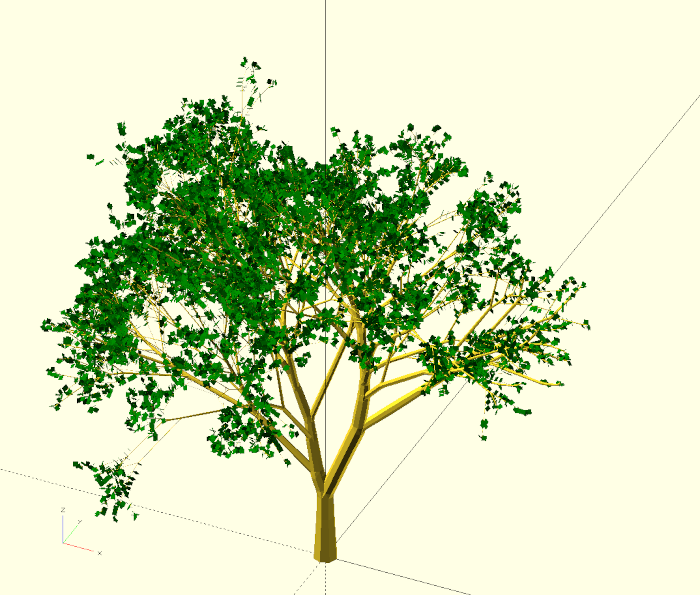

If you have experienced pure Functional programming, you'll know pure Functional programming has no loop, which only exists in imperative programming. When echo(sum) is executed, the printed value is actually 0 + a.Īs for the sum variables in sum = 0 and the last statement echo(sum), they are in the same scope so have the same value 0.īecause OpenSCAD doesn't throw an error when you re-assign a value to a variable, it might be hard for you to understand the above code in the beginning. Then the result is assigned to a new variable sum on the left side of the assignment operator.

Every time OpenSCAD evaluates sum + a, the value of sum comes from the sum variable outside of the for loop. But don't think that the following code creates 3, 7, 12 and 12. The for assign each iteratvalue is assigned to the variable. The end is the final value and the increment value defaults to 1. OpenSCAD will evaluate each value in the range. The example code of Hello, OpenSCAD! demonstrates a basic context of how to use for(variable = ). Those examples are very easy so needs no further explanation. The for loop is listed in the Other category of OpenSCAD CheatSheet. As a beginner, it's enough to think that variables are immutable in OpenSCAD, such as variables in pure Functional programming. Variables are set at compile-time, not run-time explains why there's such behavior. You can see two “ECHO: 2” in the Console, which is in the bottom of OpenSCAD. In the same variable scope, the variable will keep the last assigned value, no matter where you query the variable. If you assign values to a variable repeatedly, OpenSCAD will not throw an error. OpenSCAD, however, has differences from pure Functional programming. If someone asks me what Functional programming can do, OpenSCAD is one more example I can list. I'm able to handle OpenSCAD with ease now. Like anything else, if you do enough of it, you eventually get the hang of it. I suddenly realized that it's Functional programming and needs different thinking from imperative programming, so I have to rewrite those fundamental functions.įunctional programming is not a problem. After writing some fundamental functions, I tried to modify a vector and problems happened. I used the imperative style in the beginning. OpenSCAD is a Functional programming language,as such variables are bound to expressions and keep a single value during their entire lifetime due to the requirements of referential transparency.īecause of learning by doing, I didn't notice that OpenSCAD is Functional programming when I implemented Maze generator. But be aware of the description documented in Variables. my_text = "Hello, OpenSCAD!" Īt first glance, they might look unremarkable, only like variables in dynamically-typed languages. They were classified into Syntax in OpenSCAD CheatSheet. The things you encountered first are OpenSCAD variables. Here, I'll elaborate these elements according to the content of OpenSCAD CheatSheet. I think this one probably does constitute a small error.In Hello, OpenSCAD!, you've seen several elements in a basic OpenSCAD program, such as variables, for syntax, cube, text modules, translate, rotate transformations and so on.

I've only looked at the one shape but I notice with the cylinder that without labels the second vale is assumed to be "r1" rather than "r", which means there is no specified value for "r2" so it is given a default value of 1. The label might be redundant, but I don't see any need for it to break the code. Within the parenthesis of a function, If you put a labeled variable in front of an unlabeled variable, (even if it is in sequence) this seems to foul up the operation. Hay guys, I only just noticed these quirks to do with inputting arguments, and was curious to know what other people made of them, would you consider them bugs? There are a lot more that needs to be done to make it as (or even more) usable as the native OpenSCAD GUI, but I plan to get there in the coming month. If you guys want to take a look, here’s what that looks like: I’ve started experimenting with the idea, and while there is still a lot to do and a lot to figure out and optimize in terms of workflow, I have built something that has reached usability level. So, I’ve had an itch I wanted to scratch for a very long time: the power and quickness of OpenSCAD for modeling, married with the power and depth of Blender for 3D navigation (and many other things). However, I am also a very long time Blender user, which IMO is unparalleled in the FOSS world for many things, but specifically for 3D navigation and interacting with 3D geometry in general. Long time user of OpenSCAD here, which - as someone with a coder background - is my favorite tool for creating quick CAD-like objects.


 0 kommentar(er)
0 kommentar(er)
